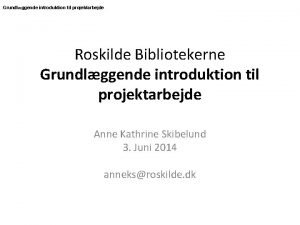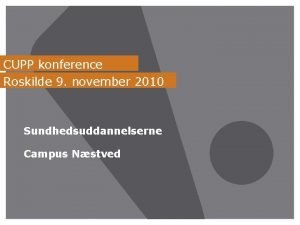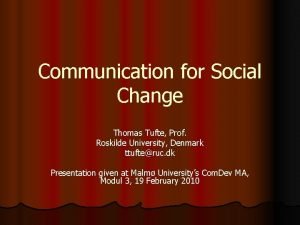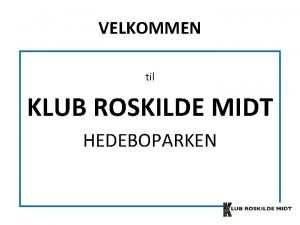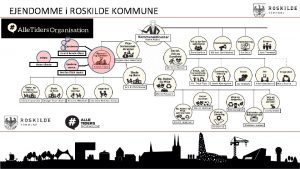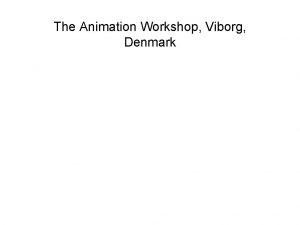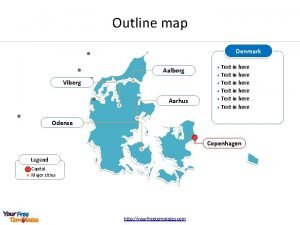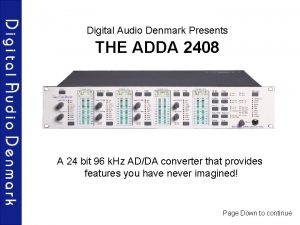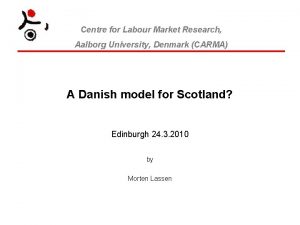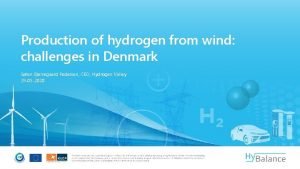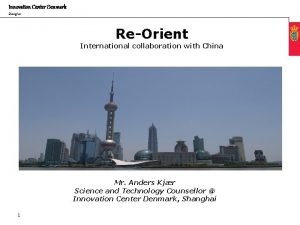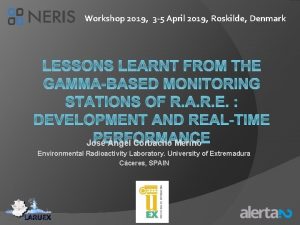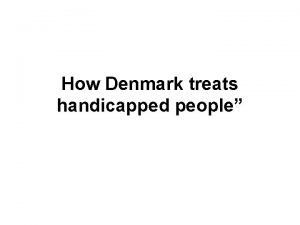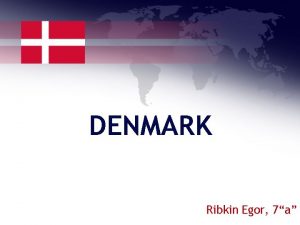International NADAConference in Denmark Roskilde 6 7 th




















![STRATEGY KEEP IT SIMPLE: [Business as usual] vs [Business as usual + NADA] www. STRATEGY KEEP IT SIMPLE: [Business as usual] vs [Business as usual + NADA] www.](https://slidetodoc.com/presentation_image_h/0f55658bcd267b40081b5e56ff1fad6a/image-21.jpg)

















- Slides: 38

International NADA-Conference in Denmark Roskilde 6. -7. th of September 2018 Kenneth Carter M. D. , M. P. H. , Dipl. Ac. Medical Director Salus. Care. Florida Acute Care & Residential Services Fort Myers, Florida USA kocarter 4@gmail, com

Session Objectives Share the journey and results from a Randomized Controlled Trial (RCT) by Carter K, Olshan-Perlmutter M, Marx J, Martini J, Cairns S NADA Ear Acupuncture: An Adjunctive Treatment to Improve and Maintain Positive Outcomes in Substance Abuse Treatment. Behavioral Sciences, 2017, 7(2), 1 -13; doi: 10. 3390/bs 7020037. Share the status of a RCT pending Institutional Review Board (IRB) approval by Carter K, Olshan-Perlmutter M, Marx J, Boisvert R A Randomized Controlled Trial Using NADA Auricular Magnet Protocol in Adolescents with DSM V Substance Use Disorders and Co-Occurring Behavioral Health Problems.

NADA “Clears the Field” • Clearing the field -- definition? Acupuncture informs Western Medicine • Clearing the field…. . of what? What is being cleared? • Clearing the field – who? where? Biopsychosocial, communal, group • Clearing the field…. . why? What comes next?

Why the Ear? 2 to 5 weeks

Why the ear? Embryonic Development • Embryonic gill plates develop into the external ear and are comprised of tissue from all 3 embryonic layers • ectoderm • mesoderm • endoderm External ear is the only body structure where all 3 embryonic layers are represented.

Why the ear? : Embryonic Development • Early development • Regulatory systems basic to all life • Vegetative systems basic to all life • Gill plates become the ear • Later development • Central Nervous System • Autonomic Nervous System • Hypothalamic Pituitary Axis (HPA)

Millennial Chinese Texts on Ear Correspondences • Su Wen and Ling Shu • Both say, “Yin meridian channels converge on the ear, Yang meridian channels pass through the ear” • Suggestive of the ear as having unique potential for Yin/Yang [Parasympathetic/Sympathetic? ] balance

Other Mechanisms: Electromagnetic Theory • Charge particles moving through space create electromagnetic waves. • All minerals, sugars, proteins, RNA, DNA, etc. , exist in the body as charged particles and impact the ear proximally and distally by generating electromagnetic waves • Electromagnetic waves result in focused standing waveform patterns that impact/generate somatotypic regions

Other Mechanisms: Specific Physiologic Effects • Blood Flow • Breathing Rate • Endogenous peptides [eg, beta endorphin, metenkephalins, • Neurotransmitters [eg serotonin, norepinephrine, dopamine and cortisol] • Brewington, V. et al. Acupuncture as a detoxification treatment: A analysis of controlled research. Journal of substance abuse treatment 11[4], 298 -307 • Smith M O, Carter K O, Landgren K. , Stuyt E. O. Ear acupuncture in addiction treatment in B. A. Johnson [Ed. ], Addiction Medicine. Science and practice. Vol. 1 1227 -1262 2011

Animal model of NADA www. nadauk. com www. NCADCon. com #NCADCon

Kailasam VK, Anand P, Melyan Z. (2016) Establishing an animal model for National Acupuncture Detoxification Association (NADA) auricular acupuncture protocol. Neurosci Lett. , 624: 29– 33. • Animal Study. Morphine-dependent rats. • NADA vs 5 sham helix. Interdermal 25 -30 min x 6 days • Authors conclusions: • NADA acupuncture treatment can reduce morphine-induced locomotor sensitization (indication of craving) • Prevent the development of morphine tolerance in rats • Validates NADA for craving reduction • NADA could be helpful with human opioid chronic pain management. www. NCADCon. com #NCADCon

Nada Ear acupuncture in practice 1. Sympathetic Liver 5. Lung 2. Shen men 3. Kidney 2 1 3 4 5 4.

“Downstream” Benefits • Improvement in engagement and retention • Relapse prevention • Reduced alcohol and drug cravings, and withdrawal symptoms • Benefit potential is substance and symptom neutral • Associated with decrease in positive urine tests, increased program completion, improved patient satisfaction, and cost savings Bullock ML et al, (1989) Controlled Trial of Acupuncture for severe recidivist alcoholism Lancet, 1 (8652) 1435 -1439, Santasiero, RP, Cost-Effectiveness of auricular acupuncture for treating substance abuse in an HMO setting: A pilot Study. Medical Acupuncture vol. 16 no. 3 2005

“Downstream” Benefits • • • Depression Anxiety Anger Impaired concentration Decreased energy Body ache / Headaches Carter, K. O. , Olshan-Perlmutter, M. , Norton, H. J. , & Smith, M. O. (2011) NADA prospective trial in patients with substance use disorders and seven common health symptoms. Medical Acupuncture (23)3, 139 -135

“Downstream” Benefits • Stress • Impulsive Behaviors • Trauma • Harm reduction • Individual and Group Psychotherapy (especially Mindfulness Based Therapies ) Carter K, Olshan-Perlmutter M. (2015) Impulsivity and Stillness: NADA, Pharmaceuticals, and Psychotherapy in Substance Use and Other DSM 5 Disorders Stuyt, E. B. Ear acupuncture for co-occurring substance abuse and borderline personality disorder: an aid to encourage treatment retention. and tobacco cessation. Acupuncture med 2014; 32: 318 -324

Some Principles of Research Design by Dr. Michael Smith 2003 • Study comprehensively, consult before you begin • Study outcome results and personal experience because there will be little or no published, controlled studies in a new field such as acudetox. • Beware of unwarranted excessive claims. Example: the 5 million dollar CATS study. • Beware of trivial claims. Example: the Fairview study published by Bullock in JSAT 2002.

Some Principles of Research Design by Dr. Michael Smith 2003 • Exemplary--the early Bullock study (Lancet 1989) was based on extensive consultation with acudetox pioneers. • Exemplary--NADA in conjunction with a 12 Step supportive residence. • Exemplary--study by Ian Bier using the NADA protocol to stop smoking plus a substantial psycho educational group www. NCADCon. com #NCADCon

Some Principles of Research Design by Dr. Michael Smith 2003 • Social context—social bond between program and patients is critical. Example: reviewed in Margolin, Avants, Holford, J. Alt. Compo Med. 2002 Vol. 8(2) pp. 111 -21. • Remember--a controlled study is never more than an approximation of reality. High volume “real life” studies with “hard outcomes” are best. Exemplary: Michael Shwarz' paper (JSAT, 1999) www. NCADCon. com #NCADCon

Some Principles of Research Design by Dr. Michael Smith 2003 • Beware--Not "valium in a needle“. Not exclusively sedating. Balancing effect which includes arousal and increased energy, moderate sense of well being, delayed effects primarily hours or days later. • Most important effects-- little to do with immediate sedation effects. Meditation and rejuvenation are very different than sedation. www. NCADCon. com #NCADCon

Some Principles of Research Design by Dr. Michael Smith 2003 • Best Outcome--The development of self-responsibility, selfactualization (not simple obedience), patient takes charge of his/her own recovery. Example: Reed Academy study and Therapeutic Community data. • Supportive of self-actualization and growing independence-- NADA acupuncture, 12 Step, Drug Court, for example www. NCADCon. com #NCADCon
![STRATEGY KEEP IT SIMPLE Business as usual vs Business as usual NADA www STRATEGY KEEP IT SIMPLE: [Business as usual] vs [Business as usual + NADA] www.](https://slidetodoc.com/presentation_image_h/0f55658bcd267b40081b5e56ff1fad6a/image-21.jpg)
STRATEGY KEEP IT SIMPLE: [Business as usual] vs [Business as usual + NADA] www. NCADCon. com #NCADCon

NADA Ear Acupuncture: An Adjunctive Therapy to Improve and Maintain Positive Outcomes in Substance Abuse Treatment • Winthrop University/Keystone Substance Abuse Services Center in Rock Hill, South Carolina • Objectives –determine if NADA plus traditional treatment is better in improving and sustaining treatment outcomes including: quality of life and psychiatric symptoms, maintaining abstinence from drug, alcohol and tobacco, and decreasing healthcare utilization. • Design -- Prospective, computer randomized, controlled study; [traditional Treatment] versus [ traditional Treatment + NADA Protocol] • Setting -- Keystone Substance Abuse Service 32 week outpatient treatment setting in Rock Hill, SC • Participants -- 50 patients in each treatment arm (100 total)

Patients Were Randomized to Traditional Treatment or Traditional Treatment Plus NADA Protocol • Traditional group: received all programs offered at KSS IOP substance abuse program which included: individual therapy, 12 Step orientation, and a variety of group therapies • NADA group: Patients received 5 bilateral ear acupuncture points (NADA protocol) in a group setting twice weekly throughout there stay at KSS IOP substance abuse program in addition to traditional treatment

Method 1. Upon program admission and completion Quality of Life and Satisfaction Questionnaire 2. PHQ-9 Depression Screening 3. GAD-7 General Anxiety Disorder Screen 4. Drug Screens Upon program completion and 3 and 6 month follow up 1. Patients self-reported alcohol, tobacco, and drug use 2. Healthcare utilization

Nada Protocol Experience • Treatment administered by a certified/licensed Acupuncture Detoxification Specialist @ Keystone Substance Abuse Services. • 5 point auricular (ear) acupuncture while seated together in a group • Needles are inserted at beginning of treatment hour and generally remain in place for 3040 minutes. • Needles are provided in sterile packages, are single use, inserted once and discarded in designated sharps disposal containers. • Needles are inserted with brief but steady movement, twirled 180 degrees for smoother insertion. • Patients may request needle removal at any time during the treatment. • Acupuncture treatments 2 x/week and patients encouraged to attend all sessions. • Patients will resume their normal treatment sessions following the acupuncture session.

Informed Risks 1. 2. 3. You may be randomized to control group and have no acupuncture for your condition for 6 months. It is possible that you receive acupuncture treatments but do not do as well as you have been doing. Because the treatment is relatively new, we may not yet know all the side effects: something unexpected could happen. Known side effects Likely • Brief ear discomfort • Minimal local bleeding upon needle removal Less Likely • Local bruising • Metallic irritation from needle • Temporary headache Rare but Serious • Vaso-vagal response (fainting)


Results • Patient characteristics: • Completion/non-completion differ by race, criminal history and initial drug test categories. • Among nonwhites a higher percentage completed the program in the NADA group. • Among patients with a positive initial drug test a higher percentage complete the program in the NADA group. • Among those with criminal history a higher percentage failed to complete the program in the control group

Results

Psychological Improvement • QLES: NADA group show a significant improvement in quality of life/Q-LES from entry to discharge. • PHQ-9: Post hoc tests: selected items in the PHQ (“feeling tired or having energy’ and “feeling bad about yourself or that you let your family down”) showed improvement for NADA group • GAD-7: No statistical difference between groups




Maintaining Abstinence • Both groups improved patients’ ability to maintain abstinence from alcohol drug and tobacco consumption between program entry and program completion. • Alcohol: NADA group better maintained abstinence at 3 and 6 months compared to traditional group • Illicit Drugs: No statistical difference (? Drug Court oversight ) • Tobacco: NADA group better maintained abstinence at 6 months compared to traditional group

Additional Results • Employment: 50% of patients in NADA group and 54. 8% patients in control group who completed the program were unemployed upon entering the program. At discharge 71% of patients in NADA group who previously were unemployed had attained some type of employment vs. 35% of control group (χ2 =4. 01, p<. 05). • Healthcare Utilization: Positive trending without p=. 05 level of significance

Stay Tuned…. . RCT pending Institutional Review Board (IRB) approval by Carter K, Olshan-Perlmutter M, Marx J, Boisvert R A Randomized Controlled Trial Using NADA Auricular Magnet Protocol in Adolescents with DSM V Substance Use Disorders and Co-Occurring Behavioral Health Problems.

THANK YOU FOR ATTENDING THIS SESSION DR. KEN CARTER kcarter@saluscareflorida. org

www. NCADCon. com #NCADCon
 Nabc metoden
Nabc metoden Konference roskilde
Konference roskilde Change roskilde
Change roskilde Klub hedeboparken
Klub hedeboparken Vuc erhverv maribo
Vuc erhverv maribo Henrik bendix olsen
Henrik bendix olsen Datamatiker hovedopgave
Datamatiker hovedopgave Oliekedler roskilde
Oliekedler roskilde Kontraktstyring roskilde
Kontraktstyring roskilde Hamlet journal entries
Hamlet journal entries Proper adjective for hungary
Proper adjective for hungary Denmark vesey
Denmark vesey Animation workshop denmark
Animation workshop denmark Aalborgviborg
Aalborgviborg Language in denmark
Language in denmark Digital audio denmark
Digital audio denmark Symbolic of the rise of physical education in sweden.
Symbolic of the rise of physical education in sweden. Michael laudrup wife
Michael laudrup wife The tragedy of hamlet prince of denmark
The tragedy of hamlet prince of denmark Market research denmark
Market research denmark Kennings for beowulf characters
Kennings for beowulf characters This breed comes from denmark
This breed comes from denmark Starter remanufacturers near me
Starter remanufacturers near me Ophelia monologue o my lord
Ophelia monologue o my lord Ministry of food agriculture and fisheries denmark
Ministry of food agriculture and fisheries denmark Capital of denmark
Capital of denmark Denmark support
Denmark support Dpa system
Dpa system Stono rebellion summary
Stono rebellion summary Hamlet characters
Hamlet characters Denmark vesey quizlet
Denmark vesey quizlet Beowulf taunt
Beowulf taunt Interesting facts about denmark
Interesting facts about denmark Hydrogen valley denmark
Hydrogen valley denmark Payday loans in denmark
Payday loans in denmark Tefl in denmark
Tefl in denmark Innovation center denmark
Innovation center denmark Demographic transition model
Demographic transition model Christmas in denmark
Christmas in denmark
